




IMAGES OF GARGUNNOCK
The village has always attracted image makers throughout the years. Painters and etchers, some of them well known in their time, have found inspiration here as have amateurs. Here are displayed about 30 of them.
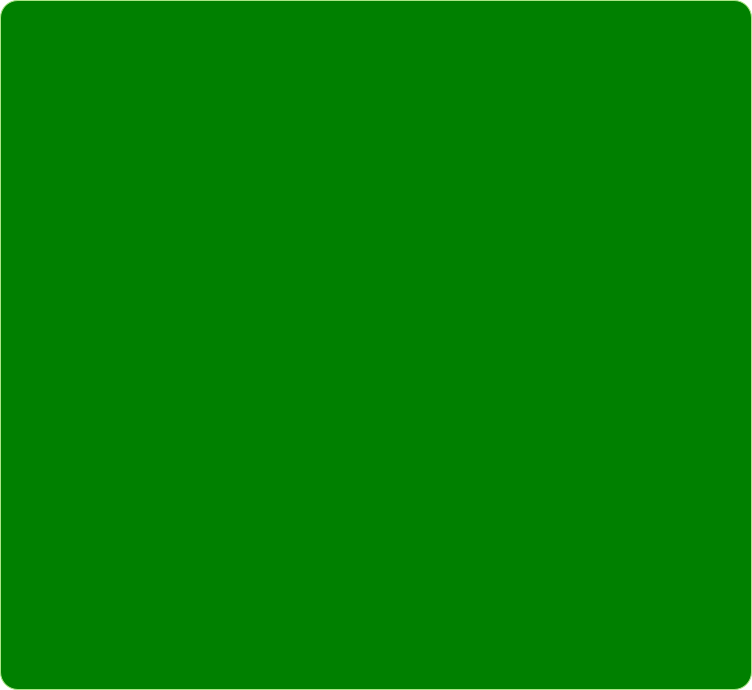

Laigh Loan & the Beild
An attractive modern painting of the westernmost access to the village, Laigh Loan, with the Beild farm beyond. Laigh means damp boggy place and there once was a Laigh Farm further down near Patrickston.
Courtesy of Ian and Anne Lees

"September Day in Gargunnock"
Archibald Russel Watson Allan ARSA, 1930s
Local girl Kath McIntyre, (nee Simpson) left the village many years ago but made contact to tell me about this painting of the village in a local museum. I phoned the curator and she kindly agreed to allow us to view and photograph it in their basement archives for an article in the magazine.
The artist was sitting on the old stone bridge in Leckie Road looking towards the rear of the houses on the north side of the Main Street . The light coloured gable end on the left is Burnside Cottage (now 2 storey). Beyond that the tallest building is the present day Gargunnock Inn and over to the top right the white faced building with the small window in the roof is Strathview, the house I was born and brought up in. The other buildings on the far side of the Main St were demolished in the 1960s.
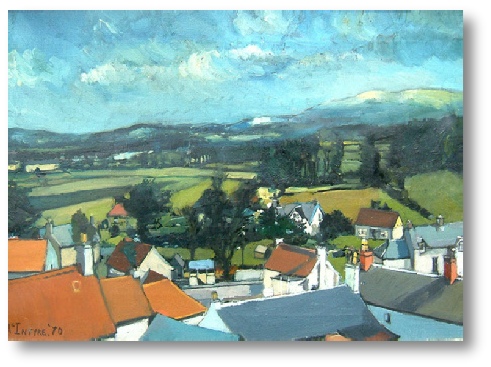
Gargunnock & the Ochils 1970 -
Joe McIntyre is a well known Scottish artist who married local girl Kathleen Simpson whose parents lived in McNeil Crescent. This view is from their upper bedroom window in 1970 looking towards the Ochils. The roof at the bottom right is that of Bridgend with the shop just to the left of it. Beyond that is Bridgend Cottage with the old wooden bus shelter to its left. On the right hand side of the picture is McNair House in the Square with Cladich beyond it then the Lea. At the left hand side in the distance is the old Distillery and Dasherhead Farm.
This painting is one of two canvasses found in the attic of the late Bobby Simpson (1942 -
Courtesy of the family of the late Bobby Simpson

Gargunnock & the Forth Valley -
Joe McIntyre is a well known Dundee artist who married local girl Kathleen Simpson whose parents lived in McNeil Crescent. This view is from their upper bedroom window in 1970 looking across the carse towards the north.
Central in this picture are two houses on the south side of the Main St. demolished in the mid 1960s to make way for the construction of pensioners houses. The one to the right had been, until a short time before, Mrs Hunter’s shop, one of two in the village. The other shop, Elsie Boag’s shop, can just be seen as the last one on the left hand sisde with grey roof. The roof of the old school can just be seen beyond that. The present day mini-
Courtesy of the family of the late Bobby Simpson
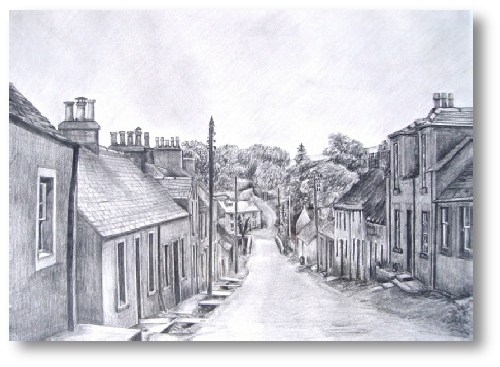
Main St., Gargunnock 1950s -
Kathleen McIntyre (nee Simpson) who married Dundee artist Joe McIntyre is an artist herself and produced this finely crafted pencil sketch of Gargunnock Main St as it would have been in the 1950s.Musk Cottage is on the left hand side followed by Carberry Cottage etc while from the right is Apple Tree Cottage followed by the two storey Roseville or “Mrs Hunter’s shop”, one of two in the Main Street at that time.
Also visible on the left is the “sheugh” or open gutter and the power poles which carried the overhead electricity cables. They were removed only relatively recently in the early 2000s
Courtesy of Kath McIntyre
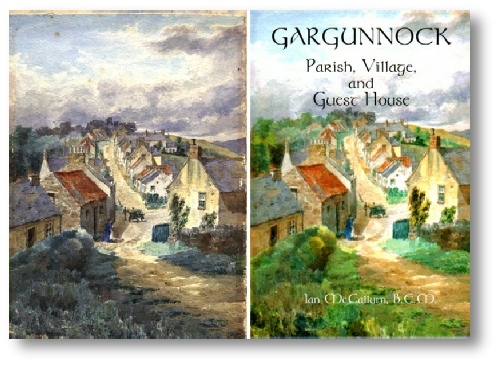
Gargunnock c1860 (artist unknown)
The left hand watercolour is the property of Gargunnock Parish Church and shows the village, Manse Brae and Main St in a bygone age. The years have caused some of the colours to fade, particularly the greens, to shades of blue.
When Ian McCallum was looking for a picture to adorn the front cover of his book about Gargunnock I took the opportunity to renew the greens and lighten it overall to give it a bit more punch.
Courtesy of Gargunnock Parish Church

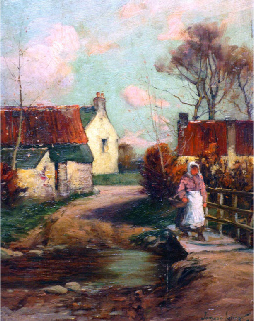
The Square, Gargunnock -
Although unsigned the left hand painting is probably by Tomson Laing who painted the other two around the turn of the 19th & 20th centuries. It surfaced in Biggin Hill in Kent and I used it on the front cover of an edition of the Gargunnock News. On the left it depicts McNair House, Glenfoyle Cottage and the Guest House (now Trelawney Cottage) with the White House beyond and the Church higher up. The season is autumn.
The middle one, signed by the artist this time, shows virtually the same scene on a winter’s day. Again this featured on the cover of the Gargunnock News. It was sourced by a local art dealer, and is back in the village now.
The right hand one depicts the point on the Mill Loan where the burn flowed across and over McGregor’s Lynn, hence the footbridge on the right. This existed up to c1960 when the burn was piped. The house on the left is Rhone Cottage, centre is the White House while the one on the right is Klondyke Cottage which was removed when the Rest Garden was formed in the 1930s. This painting came to light when I met an old school friend and retired farmer, Ian Bain, of Thornhill whose family had owned it for a long time.
Courtesy of Marjory Broughton, Eric Dempster and Ian Bain
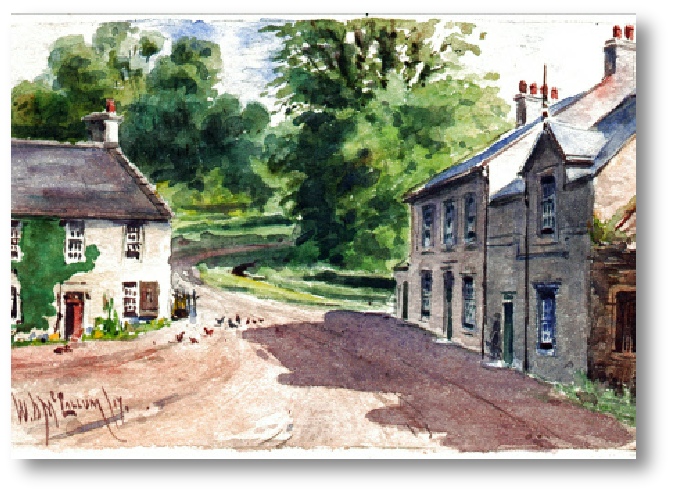
Square & Manse Brae -
You can almost feel the heat of this drowsy summer’s day in Gargunnock, can’t you? Hens graze peacefully on the dirt road of the Square undisturbed by any traffic and the building on the right, seemingly a ruin, is in it’s last stages of gentle deterioration. Its outline can still be seen to this day in the western gable of the adjacent house. The Manse Brae seems to curve to the right but that is just where the turn into Duke Street was, now the access to the “new” cemetery.
Courtesy of the late Miss Sylvia Miller
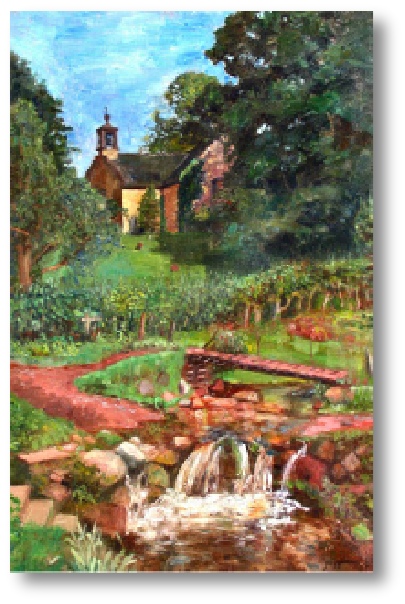
McGregors Lynn & the Church -
This one appeared out of the blue when Scott Coubrough was searching through a car boot sale at Kildean for a suitable old frame for a picture and spotted this somewhat familiar looking one. The person selling it had no idea what the subject matter was and let it go, literally, for a couple of pounds!
Interestingly it had been in the hands of a local resident here who thought it was still somewhere in her loft and had no idea how it came to be at the car boot sale.
The artist was J A Boyle who lived at the Square and was Art Master at Hillhead High in Glasgow. The hedge running across the centre now forms the southern boundary of the Rest Garden. In front of that a small footbridge allows pedestrians to cross the burn at this point where it flowed across Mill Loan and over McGregor’s Lynn.(See the Tomson Laing painting of this location) McGregors owned an adjacent feu.
Courtesy of Mr and Mrs Scott Coubrough
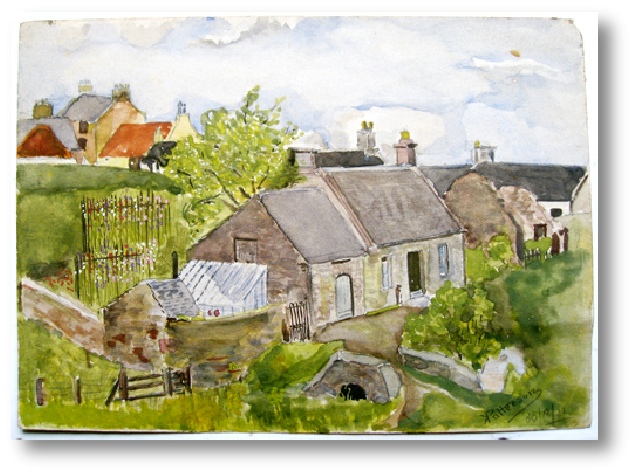
Burnbank Watercolour -
An interesting sketch done from Keir Hill which shows Burnbank with its small access bridge over the Gala burn just before it joins the Gargunnock Burn downstream from McGregors Lynn.
Beyond Burnbank lies a ruin in the grounds of Bridgend ther remainsa of which are incorporated in a garage. The tall building at the top left is the Gargunnock Inn.
Courtesy of Liz Patterson
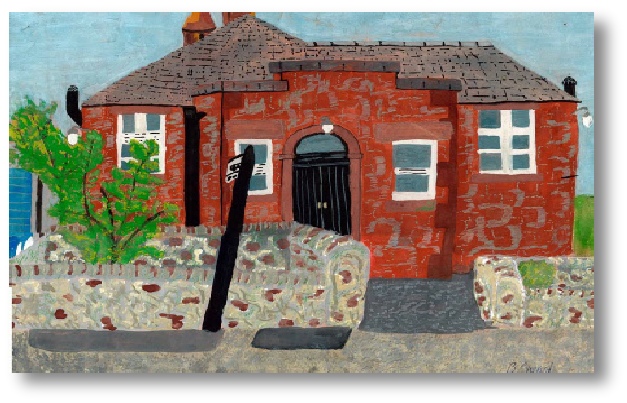
Old Church Hall -
I like this one. Painted by a very young man it shows evidence of great observation and meticulous detailing.
The old Church Hall was created out of the former Free Church in 1939, in great part due to the largesse of the former minister Rev Robert Stevenson (here 1888 to 1927) but also by public subscription.
It served well as the village hall until the early 2000s when, largely due to under-
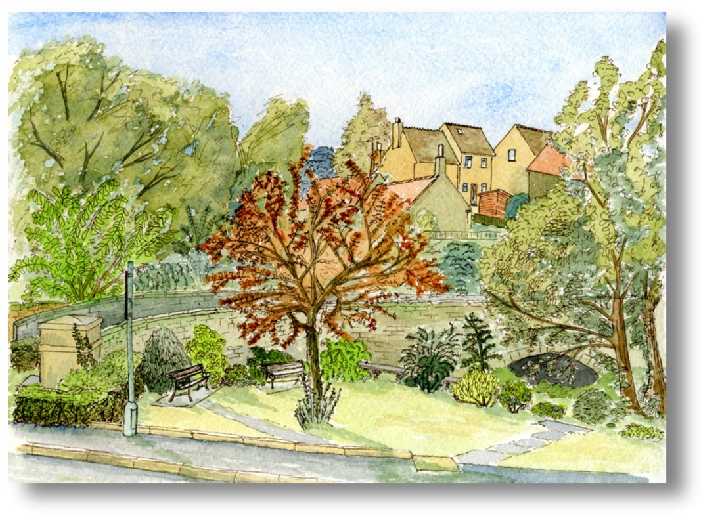
The Drinking Fountain, Bridge & Memorial Garden -
This is the view from the bedroom window of Glenfoyle Cottage.
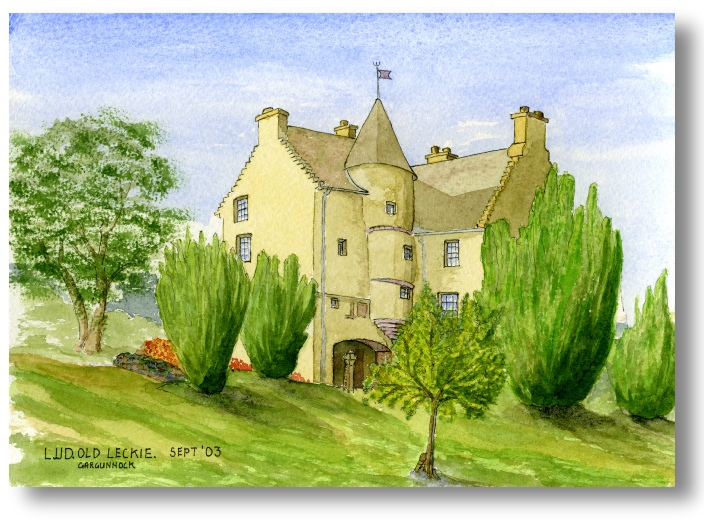
Old Leckie
A modern view of Old Leckie often called Leckie Castle
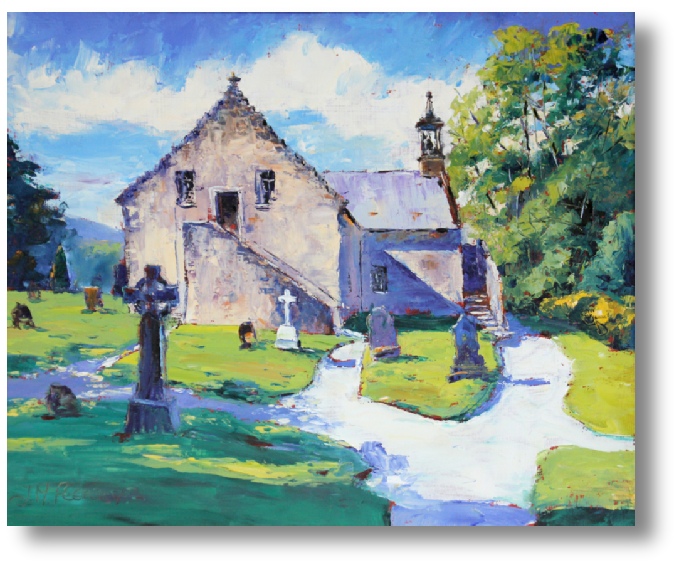
Gargunnock Church from the East
Painted during the 2000s as a commission for a visitor here from Australia who was charmed by the building and its location.

Gargunnock Church from the west
The date and the artist are unknown for this painting which is in the safekeeping of the Session.
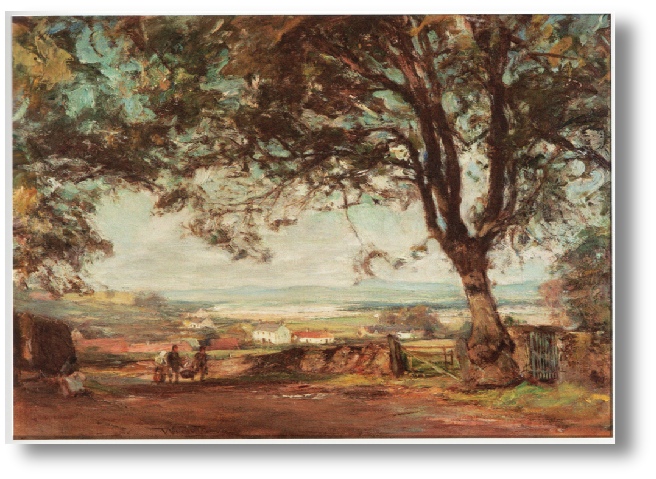
Home from Work
Sir James Lawton Wingate 1842-
This view at the top of the Manse Brae clearly shows recognisable buildings (Waterside, the School, the Basket Shops, possibly Foot o’ Green) and the view across the carse to the Perthshire hills.
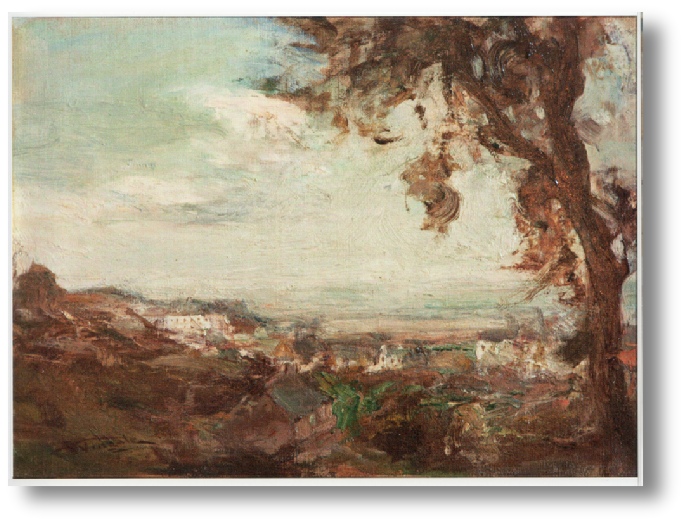
Gargunnock
Sir James Lawton Wingate 1846-
This less detailed view may have been from the top of the Keir Hill. In the foreground is Burnbank while further to the left the houses on Main St can be seen.

Red Tiled Sheds Gargunnock
Sir James Lawton Wingate
At first sight I could not quite place this painting until I recalled an old photo in my collection of the basket workshops that sat beside the White House until the 1930s’

A Grey Day in Gargunnock -
Sir James Lawton Wingate, RSA
I think we all know only too well the appearance of the Main St on a grey day. This view remained pretty much the same for the following 60 years then most of the houses on the right hand side were demolished to make way for the McNeil Crescent development.
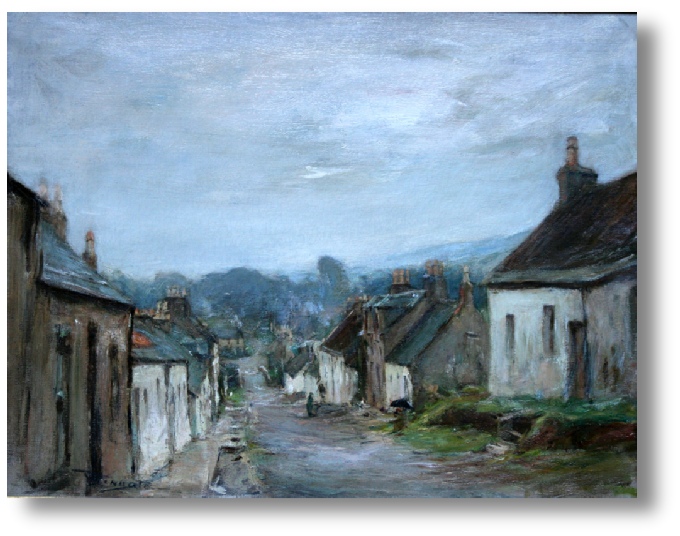
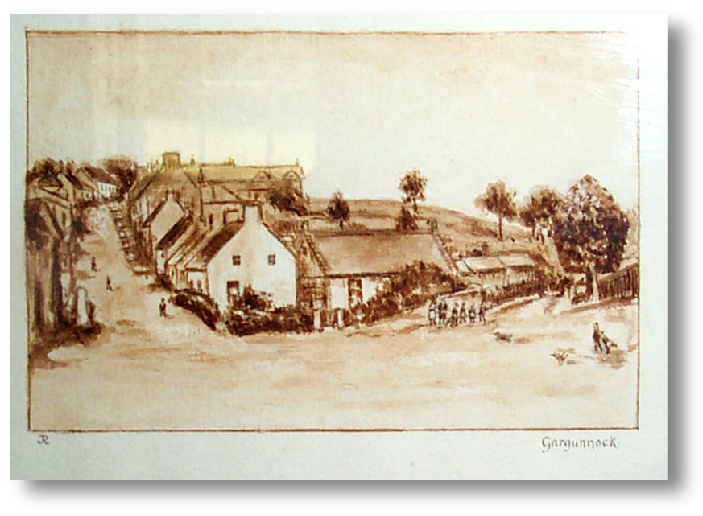
This unsigned and undated monochrome sketch hangs in Gargunnock House. The drinking fountain can just be seen so it will post-
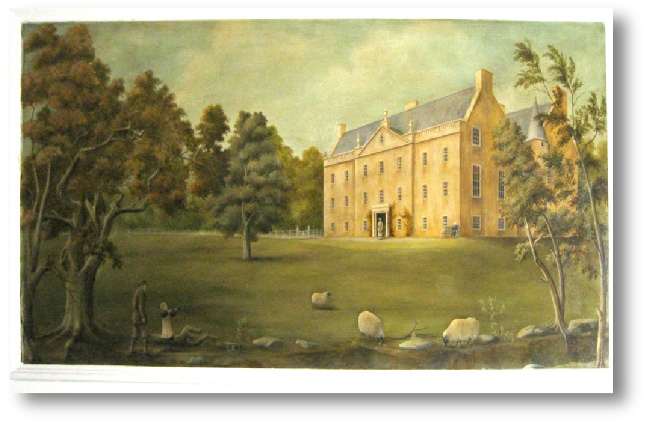
Gargunnock House
This painting hangs in the house it depicts and bears closer inspection because the tiny figure standing in the doorway is Miss VHC Stirling, dressed in her uniform, preparing to leave for service in the ATS during the war. The figure on the bench to her right may be her mother.
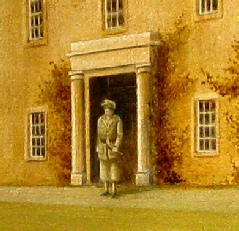
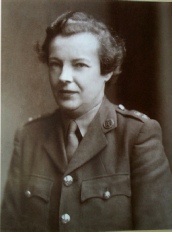
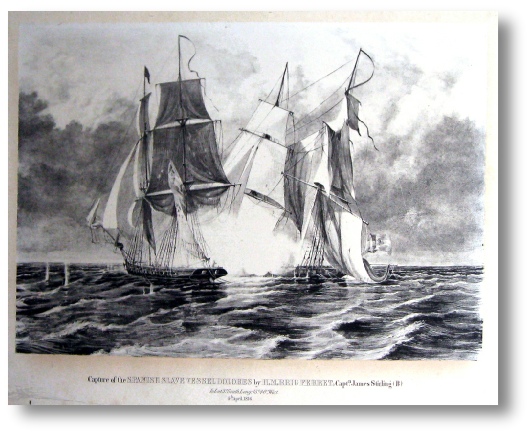
Capture of the Spanish Slave Vessel “Doldres” by HM Brig Ferret
Captn James Stirling (b) 4th April 1816
Captain Stirling, a forebear of Miss Stirling of Gargunnock House, commanded the vessel in the action shown here. Two signal canons from the Ferret are kept in Gargunnock House.
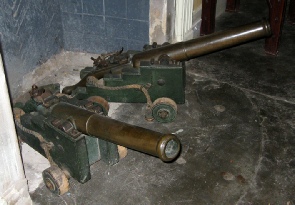
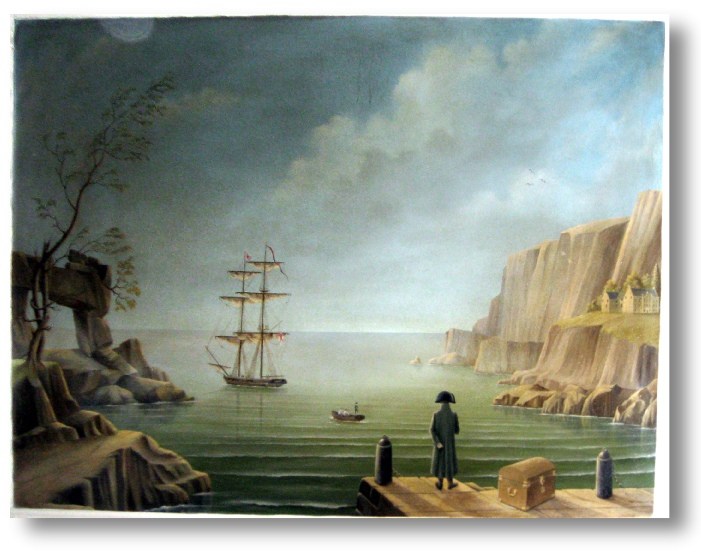
The recognisable and lonely figure of the Emperor Napoleon stands on the jetty of the island of Elba to which he has just been banished. He is looking out towards HM Brig Ferret, commanded by Captain James Stirling. Ferret was one of the ships which escorted him to the island.
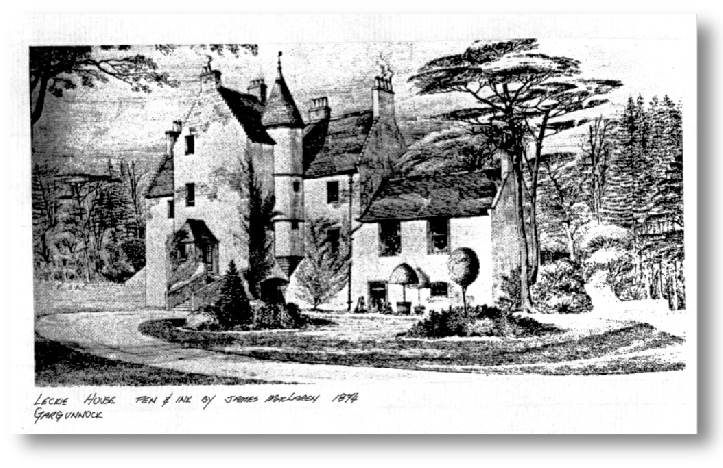
Leckie Castle (or more correctly Old Leckie)
This is a sketch made in 1874 by the well known architect James McLaren 1853-
and was a great influence on Charles Rennie Mackintosh.

Gargunnock Main St etching
D. McLeary
D. McLeary was the brother of the lady who lived in the Laft near the top of the village.
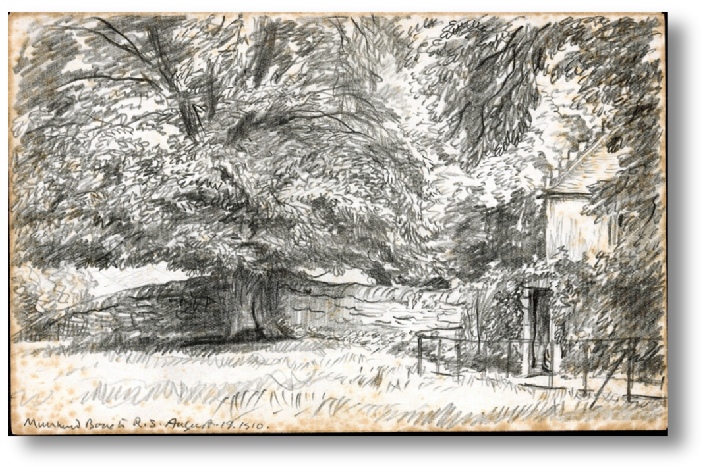
Muirhead Bone Sketch from Manse Study Window
Sir Muirhead Bone was a famous etcher from the late 19th to early 20th century and one of the first official, war artists.
He stayed for a time at the manse in 1910 (and also wrote letters from Mansefield, the old Free Church Manse at the top of the village) Standing at the study window one day (left) he sketched a view of the path taken by the minister from the manse to the churchyard each Sunday. The signed and dated sketch was returned to the Kirk Session by Dr Stevenson in the 1940s with a letter describing it and the artist.
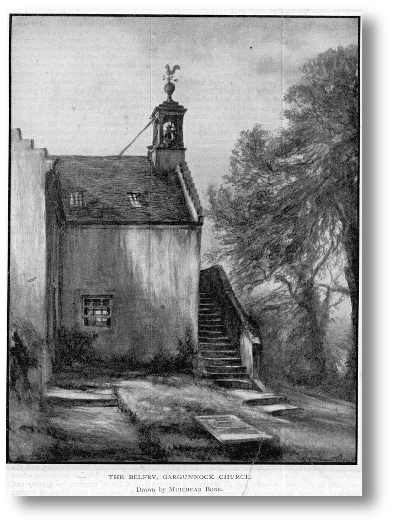
Gargunnock Church Belfry
Another etching by Sir Muirhead Bone which appeared in the Life & Work magazine.
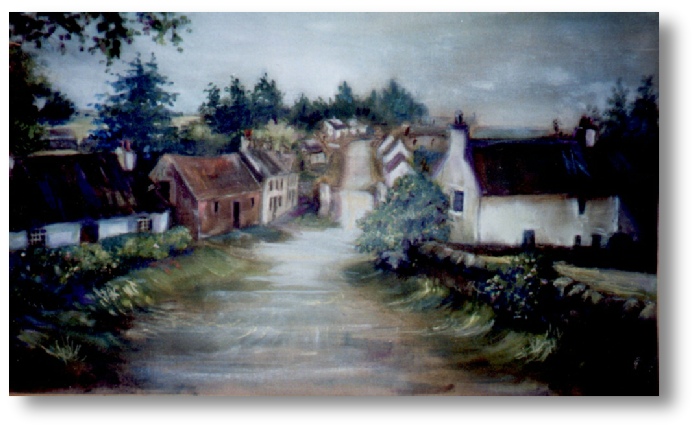
Manse Brae and the White House, Gargunnock
Unsigned or dated this unusual painting clearly shows on the left, Klondyke Cottage, demolished in the 1930s when the Rest Garden was formed. Beyond Rhone cottage and other houses in the Square while the rear of the White House is on the right. The field is a corner of the Glebe.


Mill Farm Gargunnock
Two views of the Mill Farm by the artist J A Boyle, the one on the left dated 1929, that on the right 1939
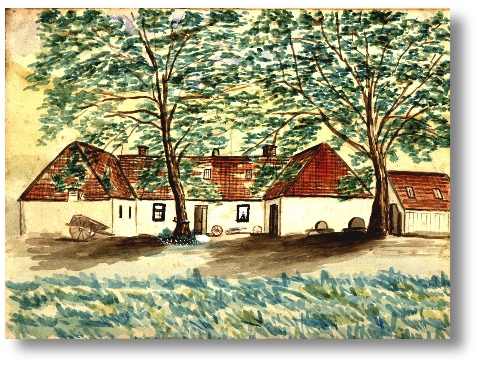
Viewfield, Manse Brae, Gargunnock
This watercolour sketch was given to me by “Molly Strang who ran the Gargunnock Pub (now the Inn) for over 40 years. She told me it was done by the well known painter Robert Eadie RSW who used to come here a lot to sketch and paint.
Viewfield was the home of the McLarens who had a sawmill to the left of the building. The right hand part of the building was the joiner’s workshop while the left hand part was a stable. As the business prospered the house was upgraded and converted to 2 storeys. The photo is dated 1928 by which time the sawmill had been re-


Viewplate at the Church
A work of art in its own right this engraved plate was installed at the top of the stairs to the Gargunnock gallery at the church by Miss VHC Stirling the last occupant Laird in Gargunnock House. Placed there in memory of two of her ancestors it shows the Perthshire hills across the valley. Not only that but it names many of them and gives their distance from the viewer.
The landscape detail at the left is what you would see if you were standing at the top of the village and looking to the left, the grove of trees marking the western boundary of Gargunnock Estate. From lower centre to the right the wall and trees were once visible from the Gargunnock gallery before the Glebe was developed.
PAINTINGS
| History Bytes |
| Statistical Accounts |
| Church History |
| Local Magazines |
| Chronology |
| Parish Magazines |
| Kirkyard Monumental Inscriptions |
| Lower Graveyard Monumental Inscriptions |